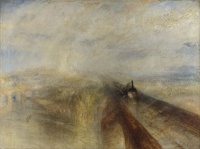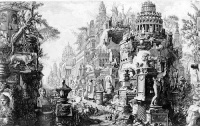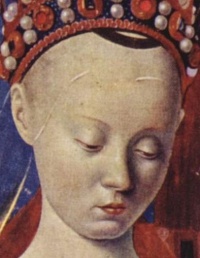Art
From The Art and Popular Culture Encyclopedia

_by_Édouard_Manet.jpg)
|
Related e |
|
Featured: |
- «La culture, c’est la règle, et l’art, c’est l’exception» --Jean-Luc Godard
- Human effort to imitate, supplement, alter, or counteract the work of nature.
- The conscious production or arrangement of sounds, colours, forms, movements, or other elements in a manner that affects the sense of beauty, specifically the production of the beautiful in a graphic or plastic medium.
- Activity intended to make something special
- A recreation of reality according to the artist's metaphysical value-judgements
- The study and the product of these processes.
- Aesthetic value.
- In printing, Artwork.
- A field or category of art, such as painting, sculpture, music, ballet, or literature.
- A nonscientific branch of learning; one of the liberal arts.
- Skill that is attained by study, practice, or observation.
Contents |
Synonyms
Antonyms
- (Human effort): mundacity, nature, subsistence
Definition
The term art is used to describe a particular type of creative production generated by human beings, and the term usually implies some degree of aesthetic value. An artist makes a work of art for various purposes, such as creating an experience for others or as part of a ritual. There is no general agreed-upon definition of art, since defining the boundaries of "art" is subjective, but the impetus for art is often called human creativity.
Art, in its broadest meaning, is the expression of creativity or imagination, or both.
Throughout the written history of humankind, various constrictions have been applied to the broad concept. Most individuals know what they consider to be art, and what they believe is not art. Additionally, groups, such as academia, have a vaguely shared notions of what is, or is not, art.
The word art is often used to refer to the visual arts, and arts is used to refer to visual art, literature, music, dance — the fine arts. However, such distinctions are the subject of many discussions and debates.
Art seems to be almost universal throughout the human race — integral to the human condition. There are no cultures that do not participate in it to some extent, and child art is created by all from about the first birthday.
Etymology
The word art derives from the Latin ars, which, loosely translated, means "arrangement" or "to arrange", though in many dictionaries the word's listing is tautologically translated as "art". This is the only universal definition of art, that whatever it is was at some point arranged in some way. A few examples where this meaning proves very broad include artifact, artificial, artifice, artillery, medical arts, and military arts. However, there are many other colloquial uses of the word, all with some relation to its etymological roots.
Research interests
- Art and politics
- Art as an excuse for depicting prurient interests
- Artworld economics
- Patronage
- Starving artist
- Tortured artist
- Byronic hero
By region
American art - Italian art - French art - Belgian art Flemish art - British art
Related
aesthetics - abstract art - advertising - appropriation - architecture - art criticism - art deco - art film - art for art's sake - art history - art horror - artificial - art nouveau - artist - art music - art theory - avant-garde - beauty - commercial art - content - convention - creativity - design - drawing - erotic art - fantasy - fashion - fiction - film - fine arts - form - found objects - gaze - genre - graphic art - grotesque art - high arts - image - imagination - imitation - innovation - kitsch - low arts - medium - music - nude - originality - painting - photography - religion - reproduction - representation - Salons des Refusés - show - style - technique - taste - theatre - visual arts - The Work of Art in the Age of Mechanical Reproduction
More
academic art - abstract art - anti-art - body art - conceptual art - contemporary art - dada - decadent art - decorative art - electronic art - degenerate art - expressionism - fantastic art - impressionism - Fluxus - futurism - landscape - minimalism - Mannerism - modern art - Modernism - pop art - postmodern art - romanticism - realism - renaissance - surrealism - symbolism - transgressive art
By sense
For the eye - For the ear - For the mind
Controversial art
- see also transgressive art
Theodore Gericault's "Raft of the Medusa" (1820), was a social commentary on a current event, unprecedented at the time. Edouard Manet's "Le Déjeuner sur l'Herbe" (1863), was considered scandalous not because of the nude woman, but because she is seated next to fully-dressed men. John Singer Sargent's "Madame Pierre Gautreau (Madam X)" (1884), caused a huge uproar over the reddish pink used to color the woman's ear lobe, considered far too suggestive and supposedly ruining the high-society model's reputation.
In the twentieth century, Pablo Picasso's Guernica (1937) used arresting cubist techniques and stark monochromatic oils, to depict the harrowing consequences of a contemporary bombing of a small, ancient Basque town. Leon Golub's Interrogation III (1981), depicts a female nude, hooded detainee strapped to a chair, her legs open to reveal her sexual organs, surrounded by two tormentors dressed in everyday clothing. Andres Serrano's Piss Christ (1989) is a photograph of a crucifix, sacred to the Christian religion and representing Christ's sacrifice and final suffering, submerged in a glass of the artist's own urine. The resulting uproar led to comments in the United States Senate about public funding of the arts.
In the twenty-first century, Eric Fischl created Tumbling Woman as a memorial to those who jumped or fell to their death in the attacks on the World Trade Center on September 11, 2001. Initially installed at Rockefeller Center in New York City, within a year the work was removed as too disturbing.
List of visual artists
A - Marina Abramoviæ - Vito Acconci - Jacques Fabian Gautier d'Agoty - Laurie Anderson - Arcimboldo - B - Balthus - Matthew Barney - Jean-Michel Basquiat - Aubrey Beardsley - Max Beckmann - Vanessa Beecroft - Hans Bellmer - Richard Bernstein - Gilles Berquet - Fred Bervoets - Joseph Beuys - Guillaume Bijl - Arnold Böcklin - Hieronymus Bosch - Marcel Broodthaers - Pieter Brueghel the Elder - François Boucher - C - Rupert Carabin - Caravaggio - Pierre Cardin - Paul Chabas - Lucas Cranach - Gustave Courbet - André Courrèges - John Currin - D - Salvador Dalí - Honoré Daumier - Eugène Delacroix - Luc Deleu - Wim Delvoye - Achille Devéria - Danny Devos - Otto Dix - Gustave Doré - Marcel Duchamp - Albrecht Dürer - E - James Ensor - Tracey Emin - Max Ernst - F - Jan Fabre - Eric Fischl - Henry Fuseli - Piero Fornasetti - G - Antoni Gaudí - Théodore Géricault - Jean-Léon Gérôme - H. R. Giger - Gilbert & George - Vincent van Gogh - Francisco de Goya - Dan Graham - Grandville - Hans Baldung Grien - George Grosz - Matthias Grünewald - H - Richard Hamilton - Keith Haring - Raoul Hausmann - Damien Hirst - Hokusai - Jenny Holzer - I - Jean Auguste Dominique Ingres - J - Allen Jones - Frida Kahlo - Yves Klein - Gustav Klimt - K - Mike Kelley - Jeff Koons - L - Jean-Jacques Lebel - Fernand Léger - Tamara de Lempicka - Mirka Lugosi - M - René Magritte - Edouard Manet - Piero Manzoni - Marcel Mariën - Quentin Massys - Alessandro Mendini - Claude Monet - Gustave Moreau - Otto Mühl - Pierre Molinier - Carlo Mollino - William Morris - Edvard Munch - N - Hermann Nitsch - O - Chris Ofili - Orlan - P - Panamarenko - Francis Picabia - Georges Pichard - Pablo Picasso - Giovanni Piranesi - Jackson Pollock - R - Paco Rabanne - Marcantonio Raimondi - Man Ray - Paula Rego - Jamie Reid - Félicien Rops - Peter Paul Rubens - S - Andres Serrano - Egon Schiele - Cindy Sherman - Romain Slocombe - Robert Smithson - Hajime Sorayama - Eric Stanton - T - Roland Topor - Clovis Trouille - Luc Tuymans - V - Leonardo da Vinci - W - Andy Warhol - James Whistler - John Willie - Z - Unica Zürn
Related topics
- Defining art
- Controversial art
- Abstract art
- Aesthetics, a philosophical field related to art
- Anthropology of art
- Applied art
- Art criticism
- Art gallery
- Art groups
- Art history
- Art styles, periods and movements
- Art techniques and materials
- Art therapy
- Artist
- Arts
- Beauty
- Figurative art
- Fine art
- Landscape art
- Modern art
- Design









